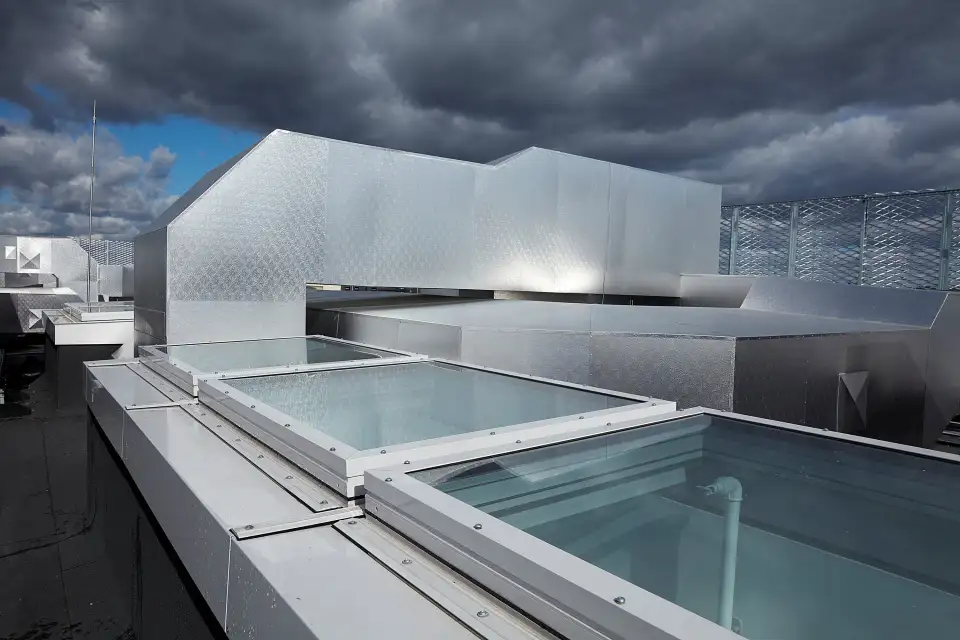
On the southern edge of London’s metropolitan area, where grey streets begin to break up into the green golf courses and farms of the English countryside, you’ll find Harris Academy Sutton School. This project sets itself apart with two outstanding achievements—it is the UK's first ever Passive House Certified Secondary School, and it is also the largest Passive House School in the world.
Completed in July of 2019, it’s no surprise the Harris Academy Sutton School’s ambitious sustainability and livability goals would find a home in this community. The school stands just a 25-minute bicycle ride from the internationally recognized BedZED Ecovillage, completed 17 years prior. While meeting the rigorous challenges required to achieve Passive House certification in such a building, a significant focus in the design was to improve the well-being of staff and students’ daily lives. Air quality, thermal comfort, and natural light play a significant role in providing an optimum environment to study, learn, and grow.
The building was designed by Architype with the 1,275 students and 95 members of staff in mind. The well-insulated and exceptionally airtight building provides ideal indoor temperatures quintessential to Passive House buildings. Through the use of LAMILUX skylights, the building provides an abundance of natural light. Daylight has been shown to improve concentration and performance, creating an organic and inspiring learning environment. The fresh air provided by the ventilation system, coupled with the exceptional use of wood and light, give the sense of being outdoors even in these architecturally modern spaces.
Artificial light and daylight in learning environments
The full light spectrum can only be found in daylight, which is why even low intensity natural light provides enough visibility as compared to electric light. Fonts are easier to read and colors easier to distinguish in daylight than in artificial light. As a result, there is less strain on the eyes. The white light color of the midday sun or an overcast day is cool and provides a clear and unfiltered color perception and continues to be superior to so-called daylight bulbs that have become better at mimicking certain aspects of daylight’s spectrum in recent years.. However, these light sources cannot be compared with daylight because they lack the necessary intensity and natural dynamics.
In England's famously overcast weather, it becomes even more important to extend the amount of exposure children have to daylight, not only to lift spirits and improve mental health by helping the body produce vitamin D, but also to boost visibility and productivity.


Glass roof system specifications
LAMILUX worked with main contractor Willmott Dixon to achieve the required light and solar performance. The triple-glazed rooflights were specified with a tempered exterior glass to surpass impact safety requirements. LAMILUX designed, supplied, and installed ten Glass Roofs PR-60 Passivhaus sets and two Smoke Lift Glass Skylight FE systems.

These glass roofs were installed throughout corridors, common spaces and the gym, bringing light to the ground floor across the four-story building. Integrated ventilation flaps were installed to provide natural ventilation and the possibility of night time cooling. To achieve the required energy standards, the Smoke Lift Skylights installed by LAMILUX included insulated curbs and frames. They were manufactured with solid insulated panels to give the best thermal performance possible. These Smoke Lift Skylights were delivered as fully factory fitted units, pre-assembled to simply fit directly to the opening in the roof deck.



The Glass Roof PR-60 Passivhaus sets the benchmark for energy efficiency standards for atrium glazing, achieving PHI’s ph A advanced component certification. The system features an installed u-value for the complete skylight of <= 0.82 w/m²k (0.14 BTU/hr/ft²/°F), utilizing triple pane glass with warm edge ‘super spacer’ as standard. The slender 60mm (2-⅜”) aluminum extruded mullion/transom glazing bar system allows for designs of almost any shape, inclination, and size which meant each of the uniquely sized rooflights were designed with flashings and interfaces to suit the bespoke project requirements. The thermally separated structure is watertight to 1200 pascals , with re1200 rating and class E to en 12208, was designed for a shallow pitch inclination, and in this case the rooflights were installed on a 3 degree pitch.
For more information about the Glass Roof PR-60 Passivhaus system and the variety of glazing solutions available from LAMILUX, one of Passive House Accelerator’s Patron Sponsors, feel free to reach out to a representative in your region. To learn more, check out the following links:
UK: LAMILUX U.K. Limited - www.lamiluxskylights.co.uk
USA & Canada: 475 High Performance Building Supply - https://www.475daylight.com
Australia: EBSA Pty Ltd - https://www.ebsa.com.au
Other countries: Contact LAMILUX head offices https://lamilux.com
